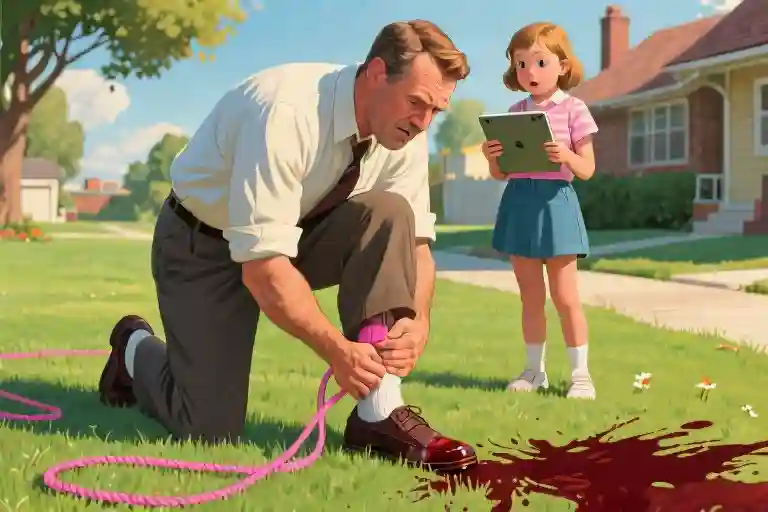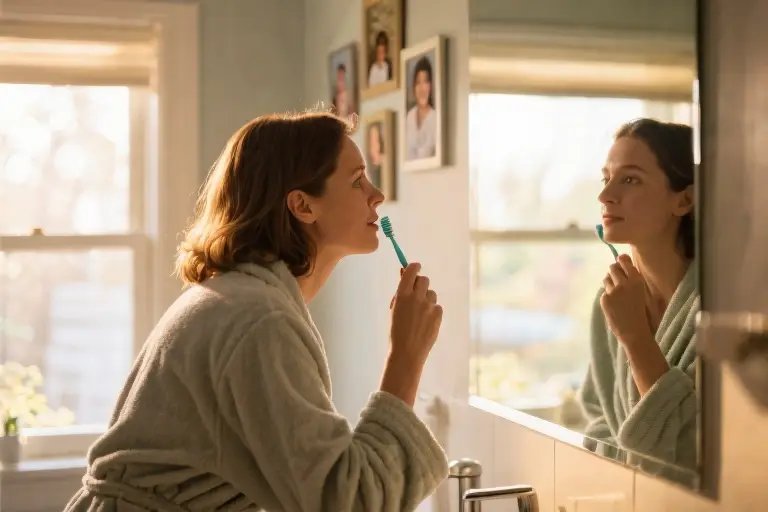The ambulance siren wailed in the distance as 46-year-old Dave Casey clutched his ruptured Achilles tendon, his face contorted in that particular shade of agony known only to middle-aged men attempting physical feats beyond their years. His ten-year-old daughter Maya stood nearby, still gripping the jump rope that had become the instrument of her father’s downfall. “I told you it was a stupid, boring thing kids used to do,” she muttered, more bewildered than concerned by the medical emergency unfolding on their suburban lawn.
This modern parenting parable began with the best intentions – one father’s attempt to bridge the generation gap between his analog childhood and his daughter’s digital world. Dave had been explaining the simple joys of 1980s pastimes when Maya dismissed jump ropes as prehistoric relics. What followed was a 30-second demonstration that would live in family lore: three overconfident bounces, one disastrous tangle of nylon around loafers, and a scream loud enough to summon neighbor Pete wielding a bag of frozen peas like some suburban first responder.
As they waited for professional help, the conversation continued between pained grimaces. “Back in my day,” Dave wheezed, “we didn’t need apps or controllers. Just a rope and pavement.” Maya examined the offending object with fresh curiosity. “But didn’t you guys have, like, actual toys?” The question hung in the summer air, embodying the cultural chasm between generations. Nearby, the abandoned iPad played a muted cartoon – the very symbol of the entertainment revolution that made jump ropes seem like artifacts in some childhood museum.
Paramedics would later confirm what Pete’s laughter already suggested: this was no isolated incident. Emergency rooms see seasonal spikes in what doctors call “nostalgia injuries” – middle-aged tendons failing spectacularly during attempts to recreate youthful glories. Yet beneath the slapstick surface lay genuine questions about how we pass down play across generations in an age when even jump ropes have Bluetooth versions. The grass stain on Dave’s khakis became an accidental Rorschach test for modern parenting itself – our well-meaning but often clumsy attempts to share the textures of our childhoods with children who experience reality through entirely different sensory languages.
The 30-Second Parenting Catastrophe
It began with the kind of confidence only middle-aged dads can muster – that peculiar blend of nostalgia and stubborn pride. Dave Casey, 46, stood in his driveway holding a bright pink jump rope, determined to prove to his skeptical ten-year-old Maya that this ‘stupid, boring thing’ had once been the highlight of playgrounds across America.
Three jumps in, physics and biology conspired against him. The rope caught his left foot with cruel precision, twisting his ankle at exactly the wrong angle. There was that sickening moment of weightlessness before gravity took over, the world tilting sideways as his Achilles tendon gave up the ghost with an almost audible snap. Later, the orthopedic surgeon would compare the damage to ‘overcooked spaghetti,’ but in that moment, all Dave could manage was a guttural yelp that brought neighbor Pete sprinting across lawns, ice bag in hand like some suburban first responder.
Between gritted teeth, Dave kept insisting this wasn’t how it was supposed to go. Just minutes earlier, he’d been boasting about his childhood prowess – how he and his friends would spend entire afternoons trying to break personal records, the rhythmic slap of ropes on pavement counting out their victories. Maya had listened with the polite disbelief children reserve for tales of walking uphill both ways to school.
The irony wasn’t lost on anyone present. Here was a man who’d survived decades of adulting brought low by a toy designed for eight-year-olds. Pete later admitted he’d initially thought the screams came from some home improvement disaster – maybe a slipped power tool. Nobody expected the culprit to be three feet of plastic-coated cable and unchecked parental enthusiasm.
As they waited for the ambulance, Dave’s attempts at damage control took on a desperate quality. Between pained breaths, he explained how jump ropes had been the original mobile game – portable, affordable, endlessly customizable. Maya, clutching the offending rope like evidence in a crime scene, asked the question that cut deepest: ‘If it’s so fun, why did you stop?’ The silence that followed had nothing to do with his injury.
Paramedics would later note the unusual nature of the call – grown men injured by children’s toys being something of a specialty in their field. ‘Hula hoops are worse,’ one remarked while stabilizing Dave’s leg, launching into a story about a dislocated hip that did nothing for his patient’s morale. Through it all, Maya watched with the quiet fascination kids reserve for seeing their parents’ infallibility crack, the jump rope now coiled innocently at her feet like the world’s most unassuming wrecking ball.
“Didn’t You Guys Have Game Consoles Back Then?”
The paramedics were still minutes away when Maya crouched beside her writhing father, the jump rope now lying abandoned like evidence at a crime scene. “So,” she began, poking at the twisted plastic handle with her sneaker, “after you finished jumping rope, did you guys go hunt dinosaurs or something?”
Dave’s groan wasn’t entirely from physical pain. Through clenched teeth, he managed: “No, we— AUGH— we played actual games where you moved your whole body, not just your thumbs.”
Pete, the neighbor now applying an improvised ice pack (a bag of frozen peas with SpongeBob’s face printed on it), chimed in: “Your dad once jumped rope for forty-seven straight minutes at our fourth-grade field day. The teachers had to make him stop because—”
“—because the other kids wanted turns,” Maya finished flatly. “Yeah, Dad’s told that story approximately nine hundred times.” She held up her smartwatch. “Forty-seven minutes is like… three seasons of my show.”
The generational divide yawned wider with each exchange. Where Dave remembered the satisfying slap of rope against pavement and the collective gasp when someone finally missed, Maya saw only primitive repetition. Her digital world offered immediate rewards—streaks, badges, algorithmically perfected dopamine hits. The analog patience required for jump rope mastery might as well have been ancient cave painting techniques.
“Wait,” Maya said suddenly, “if you didn’t have phones, how did you know when to stop playing and go home?”
“Streetlights,” Dave and Pete answered simultaneously, then shared a look of mutual nostalgia. That simple signal—the gradual dimming of daylight replaced by the hum of orange-tinted bulbs—had governed their childhoods with Pavlovian precision.
Maya blinked. “You just… went outside? Without a plan? Without even telling your parents where—” She stopped, processing this radical concept of unstructured play. The idea seemed as foreign to her as Dave’s insistence that “double Dutch” wasn’t a coffee order.
Somewhere beneath the pain and embarrassment, Dave felt the melancholy creeping in. Not just for his damaged tendon, but for the cultural ligaments that once connected generations through shared play. The jump rope lying between them wasn’t just a toy—it was a fossil from an extinct ecosystem of childhood.
The ambulance siren grew louder, but the real injury wasn’t physical. It was the dawning realization that some experiences simply don’t translate across technological eras. No matter how enthusiastically demonstrated, some childhood joys remain imprisoned in their historical context—appreciated as curiosities, but never truly revived.
The Doctor’s Verdict and Expert Insights
The emergency room had that particular smell of antiseptic and regret as Dave lay on the examination table, his swollen ankle propped up. The young orthopedic surgeon scanned the MRI results with the practiced detachment of someone who’d seen too many middle-aged men attempting athletic feats beyond their years.
“At your age,” the doctor began, tapping the image of the ruptured tendon, “the Achilles behaves like an old rubber band that’s been sitting in a drawer for decades. You take it out expecting it to stretch like new, but…” He made a snapping motion with his fingers. The metaphor landed with uncomfortable accuracy.
Three floors above, a child psychologist was explaining to Maya why her father’s generation clung to these seemingly primitive activities. “Traditional games like jump rope aren’t just about physical exercise,” Dr. Alvarez noted, watching the girl swipe through a tablet game. “They develop what we call embodied cognition – your brain learns to calculate rhythm, spatial awareness, and persistence in ways screens can’t replicate.” She pulled up research showing children who engaged in rhythmic physical play scored 18% higher on executive function tests.
Back in the recovery room, the sports medicine specialist delivered his verdict with a mix of professionalism and barely concealed amusement. “We’re seeing a spike in what we’ve dubbed ‘Dad Injury Syndrome’ – men between 40-55 attempting to relive or prove something through childhood activities.” His safety guidelines were blunt:
- Warm up for at least 10 minutes before any sudden movements
- Assume your flexibility is half what it was at 20
- If the activity involves shouting “Watch this!” – don’t
The hospital’s parenting pamphlet included an unofficial red zone list: trampolines (42% of their adult orthopedic cases), monkey bars (31%), and yes, competitive jump rope (12% and rising). A nurse later confessed they kept extra ice packs ready every Father’s Day weekend.
What made Dave’s case memorable wasn’t the injury itself – it was the conversation overheard between shifts. As he practiced crutch maneuvers, Maya asked the resident if bones could be 3D-printed. “Because,” she explained with devastating logic, “if Dad’s going to keep trying old-people games, we should upgrade his parts.”
The real generational divide might not be about toys versus technology, but about how we define resilience. Dave’s generation measured it in jump rope counts and skinned knees. Maya’s calculates it in software updates and battery life. Both perspectives gathered in that hospital room – one in a splint, the other holding the charger.
The Hospital Room Truce
The steady beep of the heart monitor marked time in the recovery room where Dave lay, his left leg elevated in a comically oversized cast. Maya sat cross-legged in the visitor’s chair, her fingers dancing across the iPad screen with the dexterity of a digital native. The silence between them had stretched for seventeen minutes – Dave knew because he’d been counting the ceiling tiles to avoid admitting defeat.
Then came the sound: a rhythmic digital ‘thwap’ from Maya’s tablet, synchronized with tiny wrist flicks. Dave craned his neck to see his daughter playing a neon-colored jump rope game, her avatar effortlessly clearing 300 virtual jumps. “They have this at school for indoor recess,” she said without looking up. “You just swipe to jump. Wanna try?” She extended the iPad toward him like an olive branch made of tempered glass.
Dave’s phone buzzed beneath his hospital gown. A discreet glance revealed his search history: ‘children’s jump rope classes near me’ followed by ‘adult beginner jump rope\’ and finally ‘are virtual jump rope apps exercise’. He cleared his throat. “Maybe when they take this cast off. Though I think I’ll stick to being the coach from the sidelines.”
The nurse adjusting Dave’s IV chuckled as she checked his vitals. “You’re my third Achilles repair this week,” she said, snapping the blood pressure cuff. “Monday was a dad doing hopscotch, Wednesday a mom attempting cartwheels. We should start a support group.”
Maya finally looked up from her screen, her expression hovering between amusement and something softer. “You know,” she said, “the game has a two-player mode.” She rotated the iPad to show cartoon avatars of a father and daughter jumping in unison, their pixelated faces frozen in permanent grins. “We could try it together. Without the… you know.” She gestured at his elevated leg.
Through the window, afternoon light slanted across the hospital floor, catching dust motes that might have been pixels in another context. Somewhere beyond the parking lot, real jump ropes hung unused in garages and basements, waiting for a generation that might never prefer them to glowing screens. But in that moment, with the scent of antiseptic and the glow of the tablet between them, Dave understood this was their middle ground – where nostalgia met the inevitable, where good intentions found safer expressions. He reached for the iPad just as the physical therapist arrived with his crutches, the timing so perfect it could have been scripted.
The Aftermath: When Nostalgia Meets Reality
The hospital room smelled like antiseptic and regret. Dave lay propped up on his adjustable bed, his left leg elevated in a bulky cast that made him look like he’d lost a battle with a papier-mâché monster. Maya sat cross-legged in the visitor’s chair, her fingers dancing across her tablet screen with the effortless grace of a digital native. The rhythmic beeping of the heart monitor filled the awkward silence.
“So,” Maya began without looking up, “does this mean you’re officially too old for jump ropes now?” The question hung in the air between them, equal parts innocent curiosity and accidental brutality. Dave opened his mouth to defend his generation’s playground prowess, then closed it again when he felt a twinge in his immobilized ankle.
On the bedside table, Pete had left a get-well card featuring a cartoon dinosaur holding an ice pack – an inside joke about “prehistoric games.” The nurse who came to check Dave’s vitals had chuckled at it earlier, then casually mentioned she’d seen three similar cases that month. “Midlife crisis injuries,” she’d called them, marking them distinct from the skateboard fractures and trampoline sprains of younger patients.
Maya finally looked up from her screen, her expression shifting to something resembling concern. “I did try the jump rope game on my iPad,” she offered, turning the device to show him animated characters bouncing over a digital rope. “It’s kinda fun. You don’t even need shoes.”
Dave stared at the colorful graphics, remembering how his childhood jump rope had left blisters on his palms and dirt stains on his sneakers. The memory smelled like asphalt and sweat, sounded like the rhythmic slap of rope against pavement during recess. He wondered if Maya would ever know that particular flavor of exhaustion, the kind that came from physical rather than ocular strain.
“Maybe,” he said slowly, “when this cast comes off, we could try the real thing together. Outside.” He gestured vaguely toward the window where sunlight filtered through the blinds. “I’ll go slow this time.”
Maya considered this, her nose wrinkling in a way that reminded Dave painfully of her mother. “Will there be wifi outside?” she asked.
The heart monitor beeped steadily as Dave contemplated how to answer that question. Somewhere down the hall, another middle-aged parent was probably explaining the merits of kickball to equally skeptical offspring. The generational divide had never felt quite so literal – or quite so fragile – as it did in that moment, with one end of it encased in fiberglass.
Your Turn: What childhood activity have you attempted to resurrect for younger generations? Did it end in triumph, disaster, or (like Dave) a bit of both? Share your stories below – bonus points if they involve emergency rooms or incredulous children.





